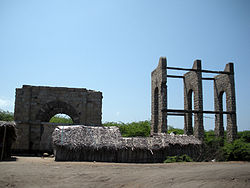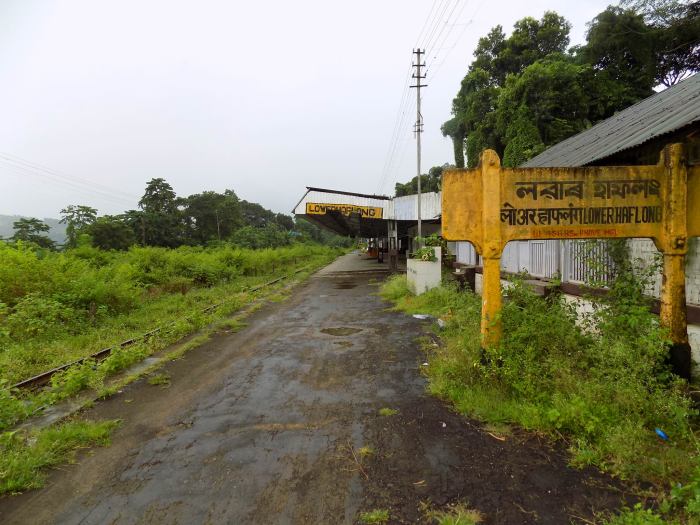Copyrights of the pictures rest with the respective photographers.
Some stations to which no train runs now.
First, one in Gujarat where the railway line does not exist now:

The picture was taken in around 1980. The station was on the long-closed NG line from Champaner Road to Pani Mines, near Vadodara.
There are many narrow gauge lines in Gujarat which have closed over the last few decades. Those which survived until the 2010s will ultimately be converted to broad gauge.
Another of these ill-fated NG lines was the Samlaya-Dabhoi section which was affected by floods some years ago . Here are some remnants:

Samlaya’s NG station. The BG station can be seen in the background.
Here is one of the wayside stations:

In Tamil Nadu, there are numerous abandoned branch lines which closed between the 1960s and 1980s. Some branches, such as the one to Mannargudi, have been rebuilt in recent years. The branch to Mettur Dam was reopened for passenger traffic after a long gap. And Karaikal has been connected through a new branch.
Perhaps the most well-known abandoned terminus is Dhanushkodi. This is all that you will see now:

The cyclone of December 1964 resulted in the closure of the Pamban-Dhanushkodi section, which was listed as the “main line” in timetables of that period. Damage to the line was extensive enough to result in it being abandoned and the branch to Rameswaram now became the main line with ferries to Talaimannar in Sri Lanka.
The disturbances in Sri Lanka from 1983 put an end to the ferry services. Though the civil war is now over and the connecting lines in Sri Lanka are functioning again, it is unlikely that the ferries will run in the foreseeable future. But Rameswaram, unlike Dhanushkodi, has enough traffic to justify train services to all parts of India.
This was once the easternmost point of IR, though the extension from Ledo was built only in the late 1950s. It was closed after the BG was extended to Ledo, and it was not felt worthwhile to convert the remaining line to Ledo to Lekhapani.

However, one can see signs of economic activity here.
This was once the terminus at Ernakulam, once metre gauge and then broad gauge. It lost its importance in around 1940 when it was bypassed in a new alignment going to Ernakulam Town, Ernakulam Jn and Cochin Harbour Terminus. In its last years it was used only by departmental goods trains, and probably the last of them ran in 2001.

And there are these recently orphaned stations on the Lumding-Silchar section: (Bagetar is the one on the top left).
Here is the station at Lower Haflong after it was abandoned:

The abandoned alignment also includes the 1.9 km-long Longtarai tunnel between Lower Haflong and Ditokcherra.
Elsewhere in Assam, here is a current picture of Tezpur station. It is not likely to see trains again as there is insufficient space for broad gauge. Trains now terminate at the BG station at Dekargaon a few km to the north.

In North Bengal, we have this former junction very close to the Bangladesh border:

It lost its importance after Partition as through trains ceased to run across the border. A newer station was built some distance away from the border and was called New Gitaldaha Jn. Limited trains continued to run to Gitaldaha according to the 1963 timetable, though it is not listed in timetables of the 1970s.
Our next stop is also in West Bengal, but on a more optimistic note:

This lies on the east of Bangaon, close to the border with Bangladesh. It saw some passenger traffic with the Sealdah/Khulna Barisal Express for some years up to the 1965 war. After that no traffic crossed the border for 25 years or more. Later goods trains from India started using the track-in 2008 many IR wagons could be seen at sidings on stations between Khulna and Jessore.
Finally a weekly express between Kolkata and Khulna started running in November 2017.
Then there were the famous narrow gauge lines of Martin Burn which ran useful commuter services on 2’0″ gauges into Howrah Maidan. They closed in around 1970. The Howrah-Amta line was converted to BG and electrified, though the Bargachia-Champadanga section remains closed.
The sister line from Howrah to Sheakhala with the short branch from Chanditala to Janai remains as it was. However, some relics can still be seen:
Ghost stations such as the older Madgaon station exist or existed until recently. The old station lies on the Konkan line about a km north of the present station.
In Hyderabad, one can see traces of platforms at Husain Sagar which was listed in timetables at least till the 1970s. A little west of Lingampalli we can see the abandoned station of Telapur on the closed line to Patancheru. That line functioned only for a few years. The expected industrial boom in the then PM’s constituency of Medak never materialized.
And the former terminus at Patancheru is taken over by vegetation:

Update: Local services were resumed in mid-2019 up to Ramachandrapuram, one station before Patancheru.
Often, old stations are bypassed or lose importance in the course of construction of a new line or bridge. Many such stations in the present NF zone were rebuilt at new locations starting in the late 1940s, which accounts for the number of “New” prefixes in this area (Think of NJP and NBQ to begin with).
One such example in Bihar is Mungeri Lal’s hometown. Here are the old and new stations:











































